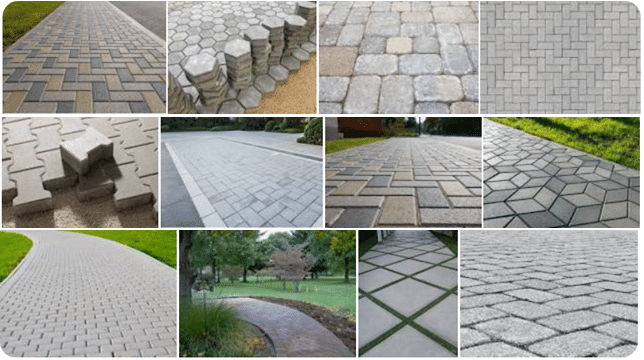
Paver Sealing and the Waypoint Sealants Edge.
Pavers and Efflorescence
Interlocking concrete pavers, or “segmental pavers,” have been used for truly thousands of years. It wasn’t until the 1940s that concrete was introduced in the mass-production of pavers.
Concrete pavers are made from a very dry mix of gravel, sand, cement, and a coloring agent. The ingredients are moved with conveyor belts and placed into molds. A vibrating press compresses the concrete into the mold, causing the small amount of water within the mixture to set the cement. Due to the use of colors and pigments, concrete floors give a wide range of colors, although the color can fade faster than brick and stone pavers. The use of sealants can help to preserve the color of concrete pavements for longer and prevent efflorescence.
Interlocking pavers used in creating a beautiful driveway.
Understanding Efflorescence
ONE. Efflorescence is the white residue that comes up from a paver and lower density concrete tiles and from polymeric sand and grout. The white residue is called calcium carbonate. Sealing over calcium carbonate will lock in the white blemish, which needs to be removed.
TWO. Calcium carbonate will disappear on its own over time, but that can take several months to more than a year. A customer will not want to see a fresh paver surface covered in a white film. Even when calcium carbonate is removed with a cleaner, the efflorescence can come back.
THREE. Calcium carbonate can be prevented from occurring. It is possible to prevent calcium carbonate from reoccurring on a surface that has been already been treated with cleaner.
FOUR. Waypoint’s professional paver sealants eliminate efflorescence from occurring/reoccurring with three simples steps: Clean pavers, apply efflorescence sealer, apply wet-look sealer.
FIVE. Many well known companies that make wet look sealers for pavers can’t prevent efflorescence. Often a company representative will recommend you wait 60 days before you seal, then suggest a cleaner product for removing the efflorescence. This common sales practice will affect your bottom line while degrading the look of your pavers.
Example of efflorescence on pavers.
You don’t have to out up with efflorescence! Waypoint’s advanced technology gives you a professional hardscape solution. This same technology in our unique mixtures offer you the most innovative and reliable paver sealers in the construction industry.
Waypoint’s Acrylic Wet Look Sealers are both film forming and penetrating. Each acrylic based sealer contains a silane (inorganic compound with chemical formula) that penetrates below the surface, forming a second layer of protection. The fortified acrylic polymer on the surface forms a powerful bond to the paver that does not delaminate. The acrylic polymer protects from liquids, vehicle oil, wine, condiments and more.
PAVER CARE – LISTED BELOW ARE SERVEON’S SEALERS AND CLEANERS FOR PAVERS SHOWING AN OVERVIEW OF THE PROPERTIES OF EACH OF THE SEALERS
The Waypoint Sealant Edge:
Only Waypoint’s Sealers…
Prevent efflorescence.
Seal in hours.
Provide Acrylic sealers that are both film forming and penetrating.
Provide more sealer choices to fit every situation:
Acrylic or Silicone Wet Look sealers
Solvent or water-base sealers
High gloss to low sheen to matte finishes
Vibrant color enhancers to no color change
Most can be used as a re-sealer for touch up and easy maintenance
Acylic sealers also perform as a joint stabilizer
Waypoint sealers for pavers have faster curing times, providing faster customer use and less inconvenience.




